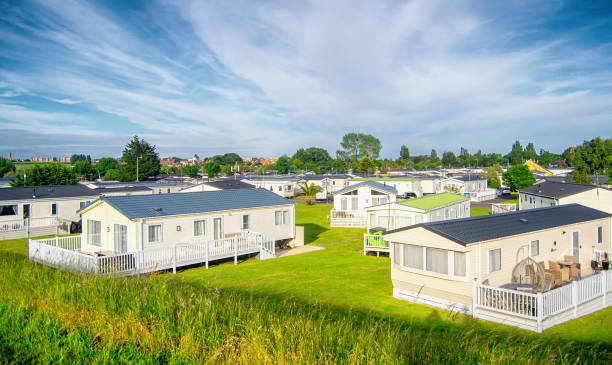Manufactured Housing Market in 2025: What’s Happening and Where It’s Headed

As we approach the halfway point of 2025, one thing is clear: the Manufactured Housing Community (MHC) industry remains one of the most resilient and attractive asset classes in real estate.
Despite a higher interest rate environment and cautious lending markets, manufactured housing continues to outperform expectations, driven by strong fundamentals, persistent housing affordability challenges, and investor demand for recession-resistant assets. At Comfort Capital, we’ve seen firsthand how well-positioned this space is—and how the macro and micro trends are aligning to make 2025 another pivotal year for the industry.
Here’s a deep look at where the MHC industry stands in 2025, how we got here, and where we believe it’s going.
How We Got Here: A Recap of MHC Momentum
Over the past decade, MHCs have transformed from a niche, mom-and-pop dominated corner of real estate to a mainstream investment target. From 2010 to 2020, MHC occupancy rose steadily, while institutional capital began to enter the space in force. Then came 2021—a record-breaking year with over $9.9 billion in mobile home park sales, fueled by low interest rates and unprecedented demand for affordable housing.
That momentum cooled in 2022–2023 as the Federal Reserve raised rates aggressively, shrinking transaction volume and widening the bid-ask gap. Still, even through macroeconomic headwinds, MHCs proved resilient: occupancy remained in the mid-90% range, rent growth outpaced inflation, and investor sentiment stayed strong.
2025 So Far: What the Data Shows
From January to May 2025, several key trends have defined the MHC space:
Sales Volume Is Steady, But Selective
Transaction activity remains below peak 2021 levels, but high-quality deals are still getting done. Portfolio sales from major players like Brookfield ($1.6B divestiture) and acquisitions from global funds like QuadReal show that capital is still flowing toward MHCs—especially for stabilized, high-occupancy assets.
Rent Growth Remains Robust
Rents continue to rise at a healthy clip, with national average increases ranging between 6% and 8% year-over-year, depending on the region. Sun Belt and Southwest markets like Texas, Florida, and Arizona are seeing the strongest growth due to population influx and limited new supply.
Occupancy Is Booming
Average occupancy across professionally managed MHCs is hovering around 95%, with REITs like Sun Communities and Equity LifeStyle reporting over 98% in core assets. With little new community construction and continued housing shortages, vacancies remain extremely low.
Shipments of New Homes Are Up
Manufactured home production surged in 2024, with over 103,000 new HUD-code homes built—a 16% increase from 2023. That momentum has carried into 2025. Through Q1, shipments were up nearly 8% year-over-year, helping communities fill vacant pads and replace aging inventory.
Cap Rates Have Stabilized
After rising during 2022–2023, cap rates have largely leveled off. Stabilized communities are trading in the 6%–7% range, depending on quality and location. Investor interest remains strong, and if interest rates fall later this year, we expect cap rate compression to return.
Policy & Lending: Supportive Tailwinds
Several policy shifts and financing updates are helping MHCs in 2025:
- Federal Zoning Reform Push: A bipartisan bill introduced this year seeks to reduce exclusionary zoning barriers that have historically blocked MHC expansion.
- HUD Support: The Department of Energy delayed costly new energy mandates for manufactured homes, giving builders and operators breathing room.
- GSE Commitment: Freddie Mac and Fannie Mae remain active lenders, with Freddie alone planning to finance $3.4 billion in MHC loans between 2025–2027.
- Trump’s Tax Bill: Though still being debated in the congress, we could see Trump’s tax bill pass this year which would reinstate 100% bonus depreciation which could cause a huge increase in transaction volume through the end of 2025.
While lending remains conservative due to higher rates, agency and specialty lenders continue to view MHCs as low-risk, cash-flowing investments.
Where the MHC Market Is Headed
Looking forward, we see continued strength in the MHC space—driven by both macro and micro forces.
1. Affordability Will Keep Demand Strong
The average manufactured housing pad rent still sits well below traditional apartment rents, even after several years of growth. This affordability advantage remains one of the sector’s biggest strengths in a nation struggling with a housing crisis.
2. Investor Competition Will Rise Again
With signs pointing toward rate cuts later this year, we expect more buyers to re-enter the market. Pent-up dry powder from family offices, REITs, and private equity will likely drive increased competition—and pricing—for quality assets.
3. Expansion & Infill Opportunities Are key
Operators that can deliver infill homes or expand existing communities stand to benefit significantly. With manufactured home shipments on the rise, the bottleneck is often in zoning and infrastructure—not in demand.
Why We’re Bullish
At Comfort Capital, we’re more confident than ever in our mission to revitalize and grow high-quality manufactured housing communities across the U.S. The fundamentals are strong, the need is urgent, and the long-term horizon is clear.
Whether you’re an investor seeking stable income or a partner aligned with our values, there’s never been a better time to get involved in this essential, undervalued sector of real estate.
